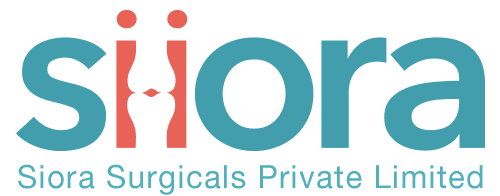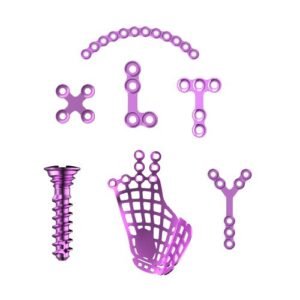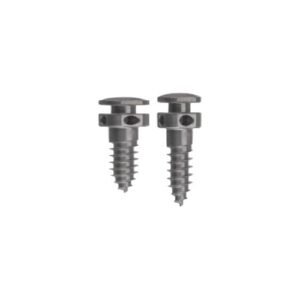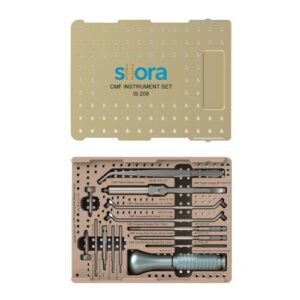Maxillofacial Internal Fixation System
The maxillofacial plating system is an orthopedic implant system designed for trauma reconstructive surgery/fixation of maxillofacial fractures on the chin, mandibles, craniofacial skeleton, and midface. This system consists of plates, screws, and instrumentation for correct placement and manipulation of implants. We are proud to be one of the most trustworthy Maxillofacial Implants Manufacturers and suppliers across the globe. Siora also manufactures and supplies an extensive range of CE-certified orthopaedic implants and instruments.
-
MINI 0.6mm & 0.8 Maxillofacial Locking Plates, Screws & CMF Graphic Implant Set (22)
MINI 0.6mm & 0.8 Maxillofacial Locking Plates, Screws & CMF Graphic Implant Set -
MID 1.5mm Maxillofacial Locking Plates, Screws, & CMF Graphic Implant Set (18)
MID 1.5mm Maxillofacial Locking Plates, Screws, & CMF Graphic Implant Set -
MID 1.0mm Maxillofacial Locking Plates, Screws & CMF Graphic Implant Set (19)
MID 1.0mm Maxillofacial Locking Plates, Screws & CMF Graphic Implant Set -
MANDIBULAR Maxillofacial Reconstruction 2.4mm Plates, Screw & CMF Implant Set (10)
MANDIBULAR Maxillofacial Reconstruction 2.4mm Plates, Screw & CMF Implant Set -
CMF - Inter Maxillary Fixation Screw (2)
CMF - Inter Maxillary Fixation Screw -
CMF - Instrument Set (20)
CMF - Instrument Set
What is IMF in Maxillofacial Surgery?
Intermaxillary fixation (IMF) is a technique used in maxillofacial surgery to stabilize fractured jaws by immobilizing the upper and lower jaws together. It helps maintain proper bone alignment during healing, particularly in cases of mandibular or maxillary fractures. During intermaxillary fixation, surgeons attach arch bars, wires, or elastic bands to the teeth or jawbone. This method of maxillofacial bone surgery ensures the bones heal in the correct position, restoring function and facial symmetry. While effective, the IMF can affect speech, eating, and oral hygiene, so it’s usually applied temporarily under the supervision of a maxillofacial surgeon.
What Type of Fixation Is Used for Maxillofacial Fractures?
Open reduction and internal fixation is among the common methods that may be used to treat maxillofacial fractures. However, there are two other procedures as well:
Maxillomandibular Fixation (MMF)
Maxillomandibular fixation is a common method that is performed to stabilize jaws by wiring the upper and lower teeth together to promote fracture healing.
Intermaxillary Fixation (IMF)
A form of MMF that uses elastics, arch bars, or screws to align the jaws properly.
Advantages of Using a Maxillofacial Plating System in Facial Fracture
There are several advantages of using the Maxillofacial Plating System for treating facial fractures:
- Offers stable fixation while ensuring faster bone healing
- Known to effectively restore facial structure and symmetry
- Minimizes the need for prolonged stabilization
- Reduced risk for malunion and nonunion
- Allows early return to jaw movement and functions
- Helps maintain correct anatomical alignment
- Minimizes the risk of post-surgical complications
- Better patient recovery and improved outcomes
- Suitable for complex and comminuted fractures
- Can be used with minimally invasive surgical techniques
Surgical Technique for the Maxillofacial Plates and Screws
Application of locking maxillofacial straight bridge plate and other CMF implants require expertise and careful planning depending on the type and severity of condition being treated. Here is a general technique that a surgeon follows while handling maxillofacial internal fixation system:
Pre-operative Planning
Careful assessment of the fracture or defect site using radiographs or 3D imaging guides the choice of maxillofacial implants. The location, type, and load-bearing requirement determine the selection of maxillofacial surgery plates and screws.
Incision and Exposure
A sterile approach is made to the site through intraoral or extraoral incisions, depending on the location. Adequate soft tissue retraction ensures optimal visibility of the bony structures.
Reduction of Fracture
The bony fragments are aligned using reduction forceps or manual manipulation. Accurate anatomical reduction is essential for functional and aesthetic outcomes.
Plate Selection and Contouring
Appropriate maxillofacial plates are chosen and manually contoured to adapt to the bone’s natural anatomy. Low-profile titanium plates are commonly used for better biocompatibility and reduced palpability. More importantly, it is necessary to source them from a reliable maxillofacial locking plate manufacturer.
Fixation with Screws
Pilot holes are drilled, followed by the insertion of maxillofacial surgery screws. Bicortical or monocortical fixation is selected based on the surgical site. To ensure accurate implant placement, it is important to use the right oral maxillofacial surgical instruments.
Verification and Closure
Fixation is checked for stability and alignment. The surgical site is then irrigated and closed in layers.
Post-operative Care
Follow-up includes radiographic verification and infection control, ensuring proper healing with the maxillofacial implants in place.
For details about distributorship of the international standard range of orthopedic devices, contact us, renowned and experienced orthopedic implants manufacturers.






